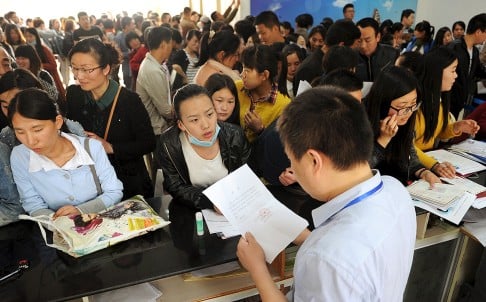NEWS›CHINA›ECONOMY
China pulls out stops to avoid mass lay-offs as economy cools
Unemployment holding steady, but some signs of distress as growth looks on verge of slipping below 7 per cent
PUBLISHED : Wednesday, 06 May, 2015, 5:05pm
UPDATED : Wednesday, 06 May, 2015, 6:24pm
Job seekers apply for local teaching positions in Lianyungang, Jiangsu. Chinese officials are worried slowing growth could hit employment. Photo: Reuters
As growth in China’s sagging economy looks on the verge of spilling below 7 per cent, officials fearing a spike in unemployment are pulling out all the stops to avoid mass lay-offs.
State firms are being encouraged to keep idle workers employed, subsidies and tax breaks are being given to companies that do not fire their workers, and some businesses are even being enticed into hiring despite the slackening economic growth.
The measures appear to be working for now, said a senior economist at the Development Research Centre, a think tank affiliated to China’s cabinet.
“There is no big problem in employment. The top leaders are more worried about financial risks and debt risks,” said the economist, who declined to be named.
But things could change quickly.
In one of the first signs of distress in China’s labour market, the Liaoning government said in April it had slashed its this year job creation target to 400,000 from 700,000, to reflect a “severe” employment trend.
That came in the wake of data that showed Liaoning, one of three rustbelt provinces in northeastern China, grew just 1.9 per cent in the first three months of the year, the slowest of China’s 31 provinces and regions.
Disappearing job opportunities or a spike in unemployment are always a concern for China’s stability-obsessed government, especially with 7.5 million university graduates estimated to join the labour market this year.
A rise in the jobless rate could spur government to stronger policy action to cushion the world’s second-largest economy from what will this year be its slowest growth in a quarter of a century.
“As long as we can prevent people from losing their jobs and prevent social unrest, we should raise salaries and provide social security and pensions,” said a researcher at China’s powerful economic planner, the National Development and Reform Commission.
In the first quarter, when growth slipped to 7 per cent, the official unemployment rate barely budged.
It stood at 4.05 per cent at the end of March, compared with 4.1 per cent at the end of last year.
But the official figure is widely recognised as a flawed measure since it does not properly account for China’s 274 million rural migrant workers, those most vulnerable to job losses in a cooldown.
Indeed, a handful of indicators already suggest mounting pressure. A private survey of China’s factory sector showed factories had cut jobs over the past 18 months, while official data showed job creation across the country had slowed in the first quarter to 3.24 million, from 3.44 million a year ago.
Worse, a range of disappointing economic data in March stoked worries that annual growth may fall below 7 per cent in the coming months, retreating further from the 7.2 per cent growth that Premier Li Keqiang has said would be needed to create 10 million new jobs.
To keep employees in their jobs, local governments are doing what they can.
Authorities in Shaanxi in central China are giving companies that do not dismiss workers, or dismiss the bare minimum, subsidies worth half the employment insurance that they pay, according to media reports.
But Julia Wang, an economist at HSBC in Hong Kong, doubts China can avoid a rising unemployment rate for long and could struggle to hit its 10 million new jobs goal this year.
“Employment is fundamentally related to economic growth,” she said. “This year’s job creation target will be in danger. It will not be as easy for the target to be exceeded as in previous years.”



No comments:
Post a Comment